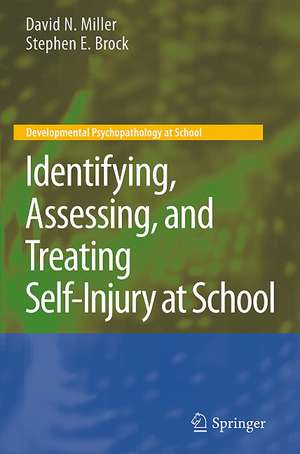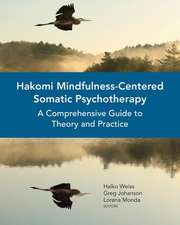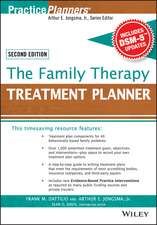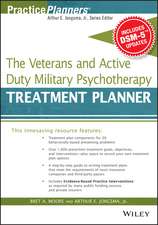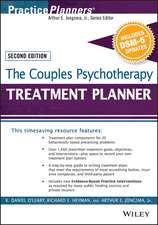Identifying, Assessing, and Treating Self-Injury at School: Developmental Psychopathology at School
Autor David N. Miller, Stephen E. Brocken Limba Engleză Paperback – 9 feb 2011
The first book specifically geared toward education personnel, Identifying, Assessing, and Treating Self-Injury at School clearly defines NSSI, differentiating it from suicidal, borderline, and other behaviors and analyzing the psychological contexts in which it occurs. This school-based perspective gives readers a practical framework for earlier, more accurate diagnosis; relevant consulting with parents, teachers, and colleagues; and effective, science-based treatment.
Included in the coverage: an overview of causes of self-injury, current findings on prevalence and associated conditions, early screening guidelines, including risk factors and warning signs, the latest information on assessment issues and diagnostic methods, a separate chapter on psychoeducational assessment and up-to-date research on interventions for NSSI.
Identifying, Assessing, and Treating Self-Injury at School offers a solid foundation for school psychologists and allied educational professionals to understand students with NSSI and address their complex needs.
| Toate formatele și edițiile | Preț | Express |
|---|---|---|
| Paperback (1) | 550.14 lei 43-57 zile | |
| Springer Us – 9 feb 2011 | 550.14 lei 43-57 zile | |
| Hardback (1) | 714.63 lei 43-57 zile | |
| Springer Us – 22 iul 2010 | 714.63 lei 43-57 zile |
Preț: 550.14 lei
Preț vechi: 579.10 lei
-5% Nou
Puncte Express: 825
Preț estimativ în valută:
105.30€ • 114.42$ • 88.51£
105.30€ • 114.42$ • 88.51£
Carte tipărită la comandă
Livrare economică 21 aprilie-05 mai
Preluare comenzi: 021 569.72.76
Specificații
ISBN-13: 9781441995124
ISBN-10: 1441995129
Pagini: 138
Ilustrații: XII, 138 p.
Dimensiuni: 155 x 235 x 8 mm
Greutate: 0.22 kg
Ediția:2010
Editura: Springer Us
Colecția Springer
Seria Developmental Psychopathology at School
Locul publicării:New York, NY, United States
ISBN-10: 1441995129
Pagini: 138
Ilustrații: XII, 138 p.
Dimensiuni: 155 x 235 x 8 mm
Greutate: 0.22 kg
Ediția:2010
Editura: Springer Us
Colecția Springer
Seria Developmental Psychopathology at School
Locul publicării:New York, NY, United States
Public țintă
Professional/practitionerCuprins
Causes (with Richard Lieberman).- Prevalence and Associated Conditions.- Case Finding, Screening, and Referral.- Diagnostic Assessment.- Psychoeducational Assessment.- Treatment.
Recenzii
From the reviews:
“Miller and Brock have written a book for those working in the environment where adolescents spend a significant portion of their time ––schools––and they discuss methods for both assessment and treatment. … very useful resource for a variety of school personnel who find themselves in the position to deal with the mental health needs of students who may engage in NSSI. … useful for parents or other professionals who would like to understand and advocate for support of a child in a school-based setting.” (Kimberly Wilson Booker, PsycCRITIQUES, Vol. 56 (3), January, 2011)
“This book … discusses nonsuicidal self-injury (NSSI) in a school setting, its etiology, assessment, and treatment. … It is intended for school psychologists and allied educational professionals, but graduate students in school psychology obviously would benefit as well. … tables and figures are very helpful and an appendix lists Internet resources. The book is easy to read … and is full of references for further investigation. … It is must reading for school personnel, who may be the first to uncover, these behavioral issues.” (Gary B. Kaniuk, Doody’s Review Service, January, 2010)
“Miller and Brock have written a book for those working in the environment where adolescents spend a significant portion of their time ––schools––and they discuss methods for both assessment and treatment. … very useful resource for a variety of school personnel who find themselves in the position to deal with the mental health needs of students who may engage in NSSI. … useful for parents or other professionals who would like to understand and advocate for support of a child in a school-based setting.” (Kimberly Wilson Booker, PsycCRITIQUES, Vol. 56 (3), January, 2011)
“This book … discusses nonsuicidal self-injury (NSSI) in a school setting, its etiology, assessment, and treatment. … It is intended for school psychologists and allied educational professionals, but graduate students in school psychology obviously would benefit as well. … tables and figures are very helpful and an appendix lists Internet resources. The book is easy to read … and is full of references for further investigation. … It is must reading for school personnel, who may be the first to uncover, these behavioral issues.” (Gary B. Kaniuk, Doody’s Review Service, January, 2010)
Notă biografică
David N. Miller, Ph.D, is an Assistant Professor in the Department of Educational and Counseling Psychology at the University at Albany, State University of New York. He received his Ph.D. in school psychology from Lehigh University. A certified school psychologist, he has extensive experience working with students with emotional and behavioral problems in both public and alternative school settings, including serving as the Director of the Predoctoral Internship in Professional Psychology at Centennial School of Lehigh University. He has more than 30 professional publications and book chapters and has conducted more than 40 national and state presentations on various topics, including self-injury and suicidal behavior in children and youth. He was also co-chair of the Suicide Prevention/Intervention Workgroup of the National Association of School Psychologists School Crisis Prevention and Intervention Task Force. Dr. Miller currently serves on the editorial advisory board of School Psychology Review, Psychology in the Schools, School Psychology Forum, and the Division 16 (School Psychology) Book Series.
Stephen E. Brock, Ph.D., NCSP, is an Associate Professor at California State University Sacramento. Previously, he worked for 18 years as a school psychologist with the Lodi Unified School District (the last six of which included assignments as Lead Psychologist). His professional preparation includes a Ph.D. at the University of California, Davis. Dr. Brock currently serves on the editorial boards of both state and national school psychology association newsletters and is an Associate Editor of The California School Psychologist (a peer-reviewed journal with the second largest distribution of school psychology journals in the United States). He is Past-President of the California Association of School Psychologists and a member of the National Association of School Psychologists’ Delegate Assembly and its Executive Council. Dr. Brock has authoredmore than 150 publications (including four books) and has made more than 80 refereed or invited state/national conference presentations. His academic work has included the study of school crisis response, suicide prevention, ADHD, autism, behavioral interventions, violence prevention, threat assessment, child development, and reading comprehension.
Stephen E. Brock, Ph.D., NCSP, is an Associate Professor at California State University Sacramento. Previously, he worked for 18 years as a school psychologist with the Lodi Unified School District (the last six of which included assignments as Lead Psychologist). His professional preparation includes a Ph.D. at the University of California, Davis. Dr. Brock currently serves on the editorial boards of both state and national school psychology association newsletters and is an Associate Editor of The California School Psychologist (a peer-reviewed journal with the second largest distribution of school psychology journals in the United States). He is Past-President of the California Association of School Psychologists and a member of the National Association of School Psychologists’ Delegate Assembly and its Executive Council. Dr. Brock has authoredmore than 150 publications (including four books) and has made more than 80 refereed or invited state/national conference presentations. His academic work has included the study of school crisis response, suicide prevention, ADHD, autism, behavioral interventions, violence prevention, threat assessment, child development, and reading comprehension.
Textul de pe ultima copertă
Nonsuicidal self-injury (NSSI) among young people—most notably in the form of forearm- or wrist-cutting—occurs across cultural groups, social strata, and developmental stages, puzzling and repelling adults. Youth engaging in NSSI behaviors are at a higher risk for suicidality as well as other mental health and academic problems. And because NSSI is often first noticed in the school setting (as is the case with many children’s disorders), school professionals are being encouraged to take a more proactive role in intervention.
The first book specifically geared toward education personnel, Identifying, Assessing, and Treating Self-Injury at School clearly defines NSSI, differentiating it from suicidal, borderline, and other behaviors and analyzing the psychological contexts in which it occurs. This school-based perspective gives readers a practical framework for earlier, more accurate diagnosis; relevant consulting with parents, teachers, and colleagues; and effective, science-based treatment.
Included in the coverage:
• An overview of causes of self-injury.
• Current findings on prevalence and associated conditions.
• Early screening guidelines, including risk factors and warning signs.
• The latest information on assessment issues and diagnostic methods.
• A separate chapter on psychoeducational assessment.
• Up-to-date research on interventions for NSSI.
Identifying, Assessing, and Treating Self-Injury at School offers a solid foundation for school psychologists and allied educational professionals to understand students with NSSI and address their complex needs.
The first book specifically geared toward education personnel, Identifying, Assessing, and Treating Self-Injury at School clearly defines NSSI, differentiating it from suicidal, borderline, and other behaviors and analyzing the psychological contexts in which it occurs. This school-based perspective gives readers a practical framework for earlier, more accurate diagnosis; relevant consulting with parents, teachers, and colleagues; and effective, science-based treatment.
Included in the coverage:
• An overview of causes of self-injury.
• Current findings on prevalence and associated conditions.
• Early screening guidelines, including risk factors and warning signs.
• The latest information on assessment issues and diagnostic methods.
• A separate chapter on psychoeducational assessment.
• Up-to-date research on interventions for NSSI.
Identifying, Assessing, and Treating Self-Injury at School offers a solid foundation for school psychologists and allied educational professionals to understand students with NSSI and address their complex needs.
Caracteristici
Clearly articulate the importance of why today’s educators need to be prepared, willing, and able to identify and serve students who engage in self-injury Provide the only and most current guidance for school psychologists on working with student self-injury in school settings Focus on the school’s role in identifying students who engage in self-injury and will be especially useful to pre- and in-service school psychologists, counselors, social workers, and special educators Includes supplementary material: sn.pub/extras
